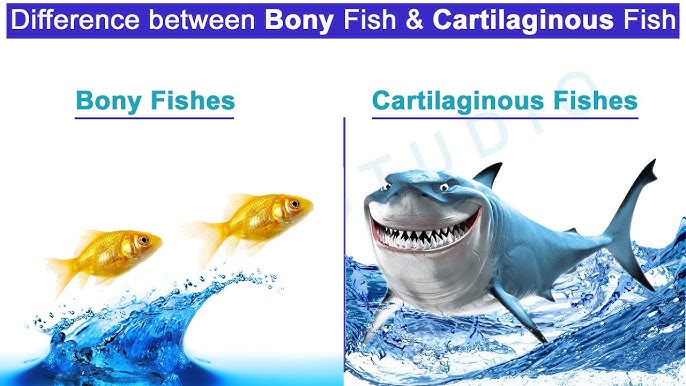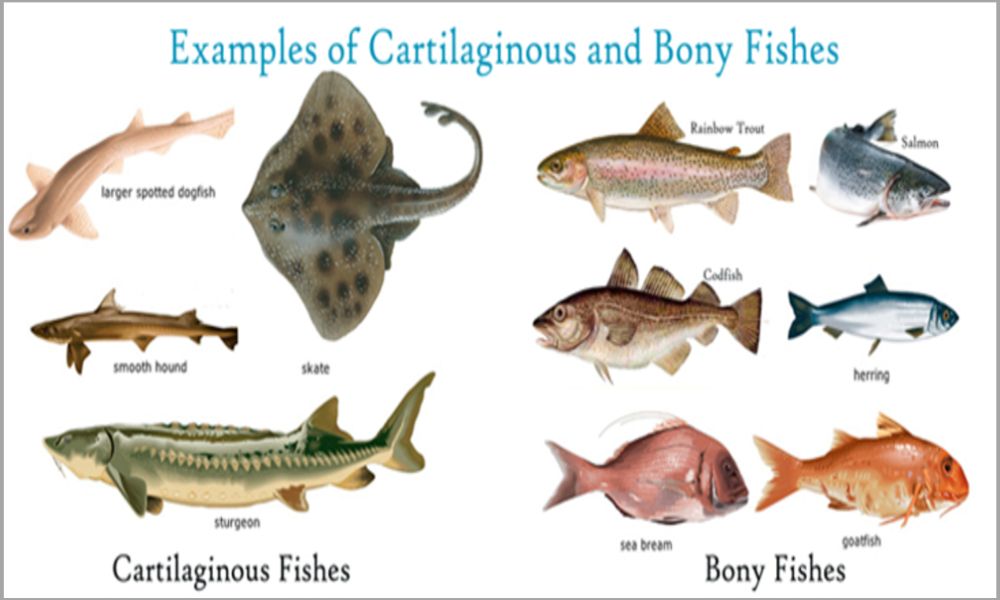Introduction
Fish are aquatic Animals that can be divided into Various groups based on their unique traits and Evolutionary histories. Two major fish Categories are Cartilaginous fish and bony fish; it is essential to understand these distinctions for gaining greater insight into all the diverse fish species that inhabit our oceans, their specific adaptations, and potential threats they pose to human lives.
Cartilaginous fish such as sharks, rays and skates are distinguished by their cartilaginous skeleton, setting them apart from bony species that possess bony skeletons for support and protection. Both groups possess distinctive body structures, reproductive strategies, respiratory mechanisms and locomotion mechanisms which give each its own distinct characteristics.
Explore the differences Between Cartilaginous fish and bony fish to gain greater insight into their Amazing diversity, their Ecological roles and evolutionary Adaptations that allow them to survive in various aquatic Environments.In the following sections we will dive deep into their differences, unveiling their distinct features and aspects as we shed light on their significance in nature.
Definition of Cartilaginous fis hand Bony Fish
Cartilaginous fish:
Cartilaginous fish are a kind of fish that has cartilage-based skeletons instead of bone. This category comprise sharks Chimaeras, rays, and. They are characterized by a slim body and a number of lines of teeth that are sharp.
The fish are also Renowned for their strong sense of Smell and the ability to detect Electrical fields within the water. They are present in fresh and saltwater environments. They play crucial ecological roles as the top predators in a variety of aquatic ecosystems.
Bony fish:
Bony Fish, commonly referred as Osteichthyes are a kind of fish with a skeleton that is made of bone instead of cartilage. This category of fish comprises the majority of species of fish including bass, trout and tuna.
They come in a variety of sizes, shapes and body forms and also have an operculum which is a bony structure that protects and covers the gills of their respective.
They are famous for their ability to regulate their buoyancy with the help of a swimming bladder. They can be found in saltwater and freshwater environments and have important ecological functions as predators and prey various aquatic ecosystems.
Comparison Table of Cartilaginous Fish and Bony Fish
Here’s a table that compares bony and cartilaginous fish:
| The Characteristics | Cartilaginous Fish | Bony Fish |
|---|---|---|
| Skeletal structure | Skeleton made from cartilage | Skeleton made from bone |
| Size and shape of the body | A streamlined, long-legged body shape. Variable in size, ranging from small to extremely large. | A wide range of body dimensions and shapes. It can be flat, round or extended. |
| Scales | Placoid scales that are tooth-like and small | Cycloid and Ctenoid scales which are flat and overlapping one another |
| Fins and style of swimming | Strong, muscular fins to propel you, as well as an heterocercal tail. | Fins are aided by bony rays or spinal spines They are characterized by a homocercal tail. |
| Lifecycle and reproduction | The majority of eggs are laid while certain species have live infants. They go through a lengthy gestation period, and their offspring are fully grown. | They can lay eggs and have live babies. Many species have shorter gestation times than cartilaginous fish. Also, offspring are not as mature. |
| Habitat and distribution | They are found in freshwater as well as saltwater environments. They are typically more prevalent in warmer waters and are usually found in coastal areas. | It is found in freshwater as well as saltwater environments, it are found throughout the world, including in the deep sea. |
| Importance | They play important ecological roles as predators of the top in a variety of aquatic ecosystems. They also have a significant economic impact since they are snared for their flesh, fins, and other items. | These are essential ecological functions as predators and prey in numerous ecosystems of water. They also play a role in economics since they are snared for their meat, sports, and for the aquarium trade. |
Note: Although these generalizations are applicable to the majority of cartilaginous and bony fishing, there may be specifics and differences within each class.

Anatomy and body structure of cartilaginous fish
Cartilaginous fish have an unique body and anatomy which is different with bony fish. Here are some principal characteristics:
Skeleton: Fish that are carilaginous have a skeleton composed of cartilage. This is more flexible and lighter than bone. This enables them to be more mobile and agile when in the water. But, it is also a sign that they are less protected to protect their organs inside them.
Skin The cartilaginous’s skin fish is covered by small, tooth-like scales referred to as dermal denticles or placoid scales. The scales are sharp and abrasive, helping reduce drag as they move through the water. They also shield skin from damage and parasites.
Fins Cartilaginous Fish have fins supported by cartilage instead of bone. There are two dorsal fins that assist in stabilizing the fish’s body in water, as well as two or more pelvic fins to aid in maneuvering and steering. Additionally, they have two pectoral fins which serve as propulsion and maneuverability, as well as an impressive tail fin, also known as a caudal fin, which is used to propel the fish.
The respiratory system Cartilaginous marine fish are equipped with five or seven gill slits along both sides of the heads. The mouth is where the water enters and flows through the gills where oxygen is absorbed as well as carbon dioxide eliminated. In contrast to bony fish the cartilaginous fish do not have an operculum that covers and shield their gills.
Organs of the senses: Cartilaginous fish have a highly developed sensory system, which includes the ability to sense sight, smell, in addition to the capacity of detecting electrical signals in the water. They also have the lateral line system composed of a number of sensory cells that sense variations in water pressure.
In general, the body shape and anatomy of cartilaginous fish are designed to adapt to their prey-style as the top predators in the ocean. Their slim body strong fins, a powerful body, as well as sharp, pointed teeth makes them effective hunter on the water.
Anatomy and body structure of bony fish
Bony fish species differ significantly in body structure and anatomy from cartilaginous ones, including their main characteristics such as:
Skeleton Bony fish possess a boney skeleton to provide additional support and protection to their internal organs, as well as buoyancy underwater. Bones are light yet hollow making the animal buoyant in water environments.
Skin The skin of bony fishes is covered by flat, overlapping scales known as Ctenoid and Cycloid scales that offer protection from injuries and parasites. These scales tend to be less rough than placoid ones while still offering some level of defense from parasites and injuries.
Fins: Bony fish possess fins which support bony spines or rays and include dorsal fin, pelvic fins and pectorals to support these structures. Their caudal fin (tail fin) may either be homocercal (symmetrical), or heterocercal (asymmetric).
Respiratory system Bony fish possess two pairs of gills which are protected by an operculum plate made up of bones. When their mouth opens and water passes over their gills, oxygen and carbon dioxide are extracted while carbon dioxide emissions occur simultaneously.
Bony fish possess aquatic bladders to control their buoyancy while swimming. By controlling how much gas fills this bladder, bony fish can adjust it according to changing levels in the column of water they inhabit.
Organs of Sensation Bony fish possess an exceptional sensory system which includes vision and smell as well as being capable of sensing water movement or variations in pressure changes.
Furthermore, bony fish possess a lateral line system consisting of sensory cells capable of sensing vibrations as well as water movement.
General, bony fish have evolved with their environments to adapt their body structures and anatomy accordingly, with various sizes and forms inhabiting both freshwater and saltwater environments.
Their swimming bladders allow them to manage buoyancy for effortless swimming in different dimensions of the column while their diverse food habits make them integral components of aquatic ecosystems in which they reside.
Conclusion
Cartilaginous fish have an outer shell composed of cartilage covered by placoid scales; fins that anchored to this outer skeleton; numerous pairs of gill openings are visible on its body structure; while bony species don’t possess this feature.
Bony fishes differ by having a bony skeleton covered with scales made up of either cycloid or ctenoid scales; fins supported by bony spines or rays; and two pairs of gills protected by operculum and aquatic bladder.Understanding these adaptations allows each species of fish to flourish within its respective aquatic environment and fulfill ecological functions effectively.
Knowing about differences amongst two groups is both valuable for researchers and enthusiasts as they will aid conservation efforts while expanding knowledge about various aquatic environments that these fish reside.







